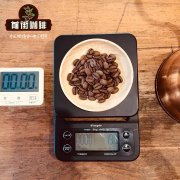Is Yunnan coffee famous in the world? what grade and grade Yunnan coffee beans belong to in foreign countries?

Professional coffee knowledge exchange more coffee bean information please follow the coffee workshop (Wechat official account cafe_style)
He has a coffee farm in southwestern Yunnan with 5000 coffee trees per hectare, growing in plenty of sunlight, a typical plantation-style layout. Catimor is a variety of options for farmers in the region, chosen because of its low sensitivity to disease and higher, faster yields. Farmers use the harvest method of washing, which has included mechanical mucus remover in recent years. Hu Xixiang stands out among these farmers-his neatly manicured land shows the concern of an expert agronomist, and his shade trees also help withstand the severe frosts of past crop years.
Yunnan Coffee Road
As a certified agricultural technician, Hu's coffee career began with his work on rubber and tea plantations. In addition to serving as a tea taster and evaluator, he also provides technical support for tree maintenance, soil balance and basic planting operations. In the end, his role as a technician led him to work with a company that was part of an early plan to grow coffee in the region.
After receiving the seeds from the local government in 1996, he planted his first cup of coffee. Although these coffee plants were severely affected by the massive frost of 1999-2000 *, the whole region was affected. With strong curiosity and never give up, he started on about 165 acres of land. In 2003, he saw the first fruits of his labor.
Hu Xixiang, a coffee farmer in Yunnan, China
"I am the son of a farmer. Since middle school, I have known that I want to devote my life to agriculture. My life is a gratitude to the land, and I want to give it back with my life, "Hu Xixiang said. (photo: Bryon Lippincott. )
Not only does he face the challenge of unstable market prices and uncertain weather, but the biggest obstacle is the lack of experience in coffee production and processing. He continues to invest profits in farms and other coffee opportunities, and in the process, he has played an important role in China's development as a major coffee producer.
Hu's experience reflects the experience of many farmers in Yunnan: they are vulnerable to huge fluctuations in market prices, and they are unable to enter diversified markets. However, the novelty of coffee cultivation poses additional challenges for Chinese farmers. Many people still have minimal experience and knowledge of coffee production throughout the process-from seeds to farm gates. The challenges posed by long-term planning and management are even more difficult. Farmers like Hu Jintao are trying to ease these challenges for Chinese farmers and continue to expand the country's coffee production.
A Young History of Yunnan Coffee
Coffee has a relatively young history in China. French missionaries first planted coffee at the end of the 19th century, but despite an initiative by the government in the 1960s, production has not taken off in the past 100 years. It was not until 1988 that coffee was commercially developed on a large scale, with the assistance of the United Nations Development Programme and the World Bank as part of another government-led project.
Coffee is mainly grown in three regions of China: Yunnan, Fujian and Hainan Island. Fujian and Hainan Island are famous for growing Robusta, which accounts for only about 5% of the country's total output. Yunnan occupies the rest of the market, mainly producing Arabica coffee. Yunnan Province, bordering Vietnam, Laos and Myanmar, has increased diversity. Because of its high yield, richness and leaf rust resistance, catimor (caturra-Timor hybrid) is the first choice for most farmers with an average elevation of 2000 meters.
The vast majority of coffee produced here is commodity-grade; prices over the past decade have been affected by market fluctuations as well as frost and other environmental factors. Although productivity is increasing and coffee consumption is becoming more and more popular, a large amount of coffee is still imported into China. Instant coffee is still the largest coffee market in China, in which Robusta coffee is widely used. Vietnam is one of the largest producers of robusta coffee in Asia, accounting for more than 50% of China's total coffee imports.
With the continuous growth of the level of production, the level of exports is also increasing. The Chinese government has increasingly encouraged companies that export coffee, providing a great incentive to do so, thus driving a significant increase in exports. In just two decades, China has gone from exporting 3.48 million kg of coffee (1994-1995) to 72 million kg (2013-2014). According to ICO, the vast majority of Chinese exports are unprocessed green coffee, while only 4 per cent are roasted or soluble products.
Important Notice :
前街咖啡 FrontStreet Coffee has moved to new addredd:
FrontStreet Coffee Address: 315,Donghua East Road,GuangZhou
Tel:020 38364473
- Prev

Which kind of brewing Ecuadorian espresso is suitable for the flavor characteristics of Ecuadorian coffee?
Professional coffee knowledge exchange more coffee bean information please follow the coffee workshop (Wechat official account cafe_style) are you ready to be blown away by Ecuadorian espresso? Some cafes surprise you. Hidden in the dark streets, they are humble on the outside and humble on the inside, suggesting nothing different. It's only after the first sip that you realize
- Next

Yunnan Coffee What is the story of Yunnan coffee beans development process and the relationship between Nestle Starbucks
Professional coffee knowledge exchange More coffee bean information Please pay attention to coffee workshop (Weixin Official Accounts cafe_style) For Starbucks, there must be a forward-looking layout for China. Grasp the source (Yunnan coffee), it is possible to support the expansion of the store. US coffee chain Starbucks announced in mid-November that it will build its own coffee farm in Yunnan, China.
Related
- Beginners will see the "Coffee pull flower" guide!
- What is the difference between ice blog purified milk and ordinary milk coffee?
- Why is the Philippines the largest producer of crops in Liberia?
- For coffee extraction, should the fine powder be retained?
- How does extracted espresso fill pressed powder? How much strength does it take to press the powder?
- How to make jasmine cold extract coffee? Is the jasmine + latte good?
- Will this little toy really make the coffee taste better? How does Lily Drip affect coffee extraction?
- Will the action of slapping the filter cup also affect coffee extraction?
- What's the difference between powder-to-water ratio and powder-to-liquid ratio?
- What is the Ethiopian local species? What does it have to do with Heirloom native species?

